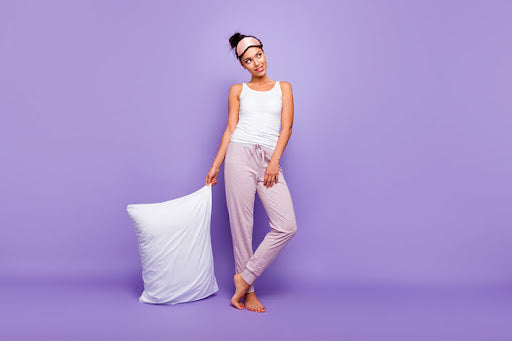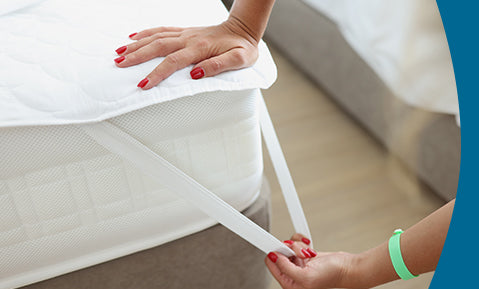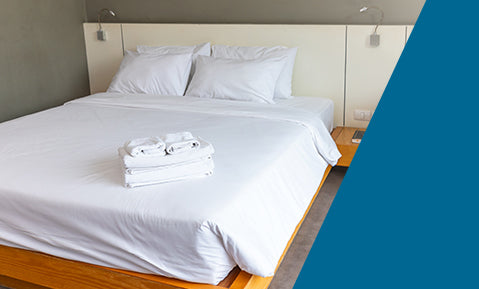
Acne , hair damage, and night sweat can result from your pillowcase. Pillowcases play both decorative and functional roles, enhancing the allure of and adding features to the pillow.
In this article, you’ll learn more about types of pillowcases.
Properties of Pillow Cases
Pillowcases, also known as pillow protectors, protect the inner fill from dust, dust mites, molds, and moisture.
Each material has a unique set of properties, including but not limited to:
- Friction: the higher the friction, the higher the damage to both your hair and skin.
- Breathable: a breathable pillow cover enables heat to escape out, keeping the pillow cool.
- Hypoallergenic: because a pillow cover is constantly in contact with your skin, it must be naturally hypoallergenic.
- Anti-bacterial: a few materials are naturally resistant to the growth of bacteria, which cause acne.
- Ease of Care: to ensure good hygiene, it should be easy to wash a pillow cover.
- Pilling problems: because of friction, short broken fibers can become tangled and create a tiny knot that appears like a ball.
- Static cling: light fabrics rub together and develop electrostatic charges, making the fabric stick together.
Table: properties of pillow case material.

Different Types of Pillow Case Designs
A pillowcase can also be classified on the basis of design:
Housewife - No border!

It’s the classic, no border, generally solid pillow cover.
Housewife pillowcases are sewn closed on one side and open on the other. You simply insert the pillow fill from the side that is open.
These are the most widely available and the most affordable pillowcases.
Oxford - Border

Fancier than the housewife style, an oxford pillowcase fancies up the pillow with its border edges - generally two inches wide.
But most people use oxford pillowcases as shams to decorate their bedroom.
Although the oxford pillowcase looks bigger, it has the same internal dimensions as a housewife pillowcase.
Bag

Popularly used in hotels, bag pillowcases have an opening on one side but no flaps to secure the fill. However, one can simply fold the flap and tuck it under the pillow to secure the fill.
Bag pillowcases aren’t recommended for home use.
Types of Pillow Cases by Fabric
Fabric of a pillowcase defines many of its characteristics. Let’s look at each unique fabric and the benefit that it adds to your pillow.
Cotton Pillow Cases
Soft, breathable, and durable, cotton pillowcases provide a cool and relaxing sleep experience. Pure cotton is considered a luxury by many, but it does cost more than synthetic fibers.
Most commonly available in solid designs, cotton pillowcases are perfect for the modern minimalist setup. And although a cotton pillowcase may be expensive at first, it is definitely worth every buck.
But a cotton pillowcase does tend to wrinkle over time, and a poor quality one is often prone to pilling.
Silk Pillow Cases
Silk is so smooth that cover materials are often compared to it. It reduces friction against skin and hair and protects them from damage.
However, it’s very costly, as it’s considered a luxury item.
Bamboo Pillow Cases
Like cotton and silk, bamboo fabric is natural, biodegradable, and eco-friendly. Since bamboo requires a small amount of water to grow, it does less harm to the environment than cotton cultivation.
It is both soft and shiny. It wicks sweat, keeping the pillow surface dry to slow down the growth of acne causing bacteria.
You can wash the fabric in your washing machine and use the dryer on low settings.
But most often, it is mixed with a synthetic fiber to make it more silky.
Polyester Pillow Cases
A synthetic fiber polyester is affordable and easy to care for. And polyester can be knitted to feel like cotton or even silk.
However, it absorbs body heat and isn’t breathable. Pilling problems and static cling make it an even worse option for a pillowcase.
Satin Pillow Cases
Made from polyester and woven to feel like silk, satin pillowcases are very smooth, because of which they reduce friction against your hair and skin.
Less friction prevents wrinkling of skin and damage to hair.
Flannel Pillow Cases
Most commonly used during the winters, flannel pillowcases absorb body heat and stay warm.
But the same warmth can exacerbate symptoms of night sweats. And the fabric promotes knotting of hair and causes a lot of friction against the skin.
Further, it requires careful washing, as the fabric can get damaged easily.
Securing the Pillow
Although pillowcases fit snugly around the pillow, the inner fill can sometimes spill out. To prevent this, you can use the following types of cases:
New pillows, especially the adjustable ones, come with zippered pillowcases, which prevent the fill inside the pillow from spilling out.
You can either purchase a zippered pillowcase or sew a zipper on a normal pillowcase.
When it comes to pillows with shredded foam or microbeads, a zippered pillowcase becomes essential.
Velcro Strips

A bit less effective but easier to use than the zippered ones, Velcro strips secure the pillow fill by simply sticking together.
However, a poor quality Velcro strip eventually loses its sticking ability and fails to secure the pillow inside the case.
Safety Pins

Lastly, the easiest way to secure a pillow fill is to use a safety pin, but there’s a safety hazard to it - a safety pin can become loose and injure you.
Throw Pillow Covers

Let's cover throw pillow covers, as they’re often used for decorative purposes in living rooms. These covers can add flair and liveliness to often banal and commonplace rooms.
A throw pillow often comes in a square or circular design, and for each type of shape, specific covers in the same shape are available.
Frequently Asked Questions
Q. What is the size of pillow cases?
Ans. A pillowcase comes in a variety of sizes. While an oxford pillowcase may appear bigger, its internal dimensions are the same as that of housewife pillowcases.
Here’s the internal dimensions of housewife and oxford pillowcases (l x b):
- Standard pillowcase: 26” x 20”
- Queen pillowcase: 30” x 20”
- King pillowcase: 36” x 20”
Q. What is a terse pillowcase?
Ans. Terse pillowcases are simply covers that don’t have any border. Housewife pillowcases are a prime example of terse pillowcases.
Q. What is a continental pillowcase?
Ans. A continental pillowcase comes in square shape with dimensions 65cm x 65cm. It comes in both oxford and housewife designs. These are usually meant for back pillows or throw pillows.
Q. How often should I wash my pillowcase?
Ans. Although some experts recommend washing the pillowcase every two weeks, we recommend you wash it every week.
And if you have an acne outbreak, then wash the pillowcase everyday because the bacteria from your face grows on the pillow surface and then transfers back onto your face and causes more acne.
Q. Reusing a Pillowcase
Ans. Pillow covers must be replaced after a year or two. But simply throwing them away is a waste of valuable resources.
Instead, you can use the pillow cover as a cleaning rug to wipe off dirty surfaces. Or you can use it as a bag for organizing different materials in your home.
Conclusion
Pillowcases aren’t simply decorative materials. They have their own unique properties: ease of care, breathability, static cling etc. Before purchasing a pillow cover, you should check its properties to enhance your sleep experience.













